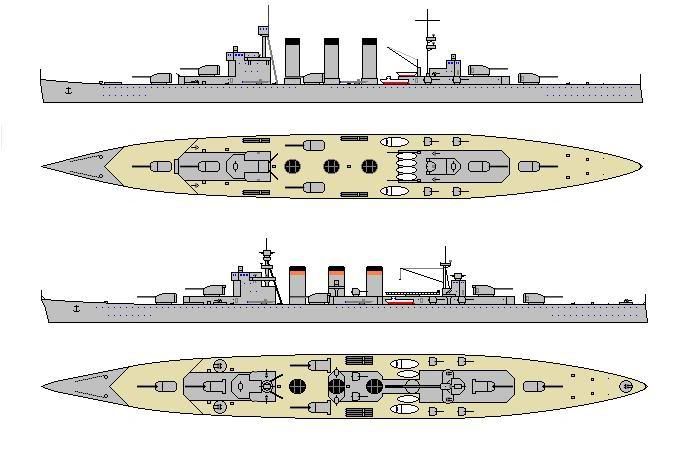The Hyderabad class CA was India's first, a contemporary of such "large light cruisers" as the British Hawkins and the Atlantean Pioneer classes - rather than being an outgrowth of traditional AC design.
The design clearly has its limitations. The battery layout, while sensible for Great War era, is now inefficiently arranged when twin turrets are available, and the desire to give the wing turrets as great a firing arc as possible limits what can be mounted on the beam forward of the turrets in particular. The range is limited, and the class is not overly suitable to long missions in the Indian Ocean.
Given that a rebuild would be expensive and not greatly improve the type, main battery layout aside, India has chosen primarily to modify the secondary and light armaments and adjust the torpedo battery. These changes give a heavier anti-surface punch with regards to the torps, and a much better anti-air suite. Two larger gun directors have been added, in addition to three small directors, and four of the turrets have their own directors.
Some superstructure and bow modifications have been made (note: the latter not changing performance significantly, more of an aesthetic thing), and a floatplane has been added aft. A new crane, similar to that being installed on the seaplane tender Gaudhi Sagar, is added to service the cat and the boats. There is, unfortunately, no room to install a telescopic canvas hanger.
Hyderabad was refitted in 1928, Bangalore will follow in 1931, and Male will receive hers in 1932.
The picture shows the original layout above, and the refit below. Stats for the original design can be found in the encyclopedia.

Hyderabad, laid down 1918, refitted 1928
Length, 182.9 m x Beam, 18.3 m x Depth, 5.6 m
8943 tonnes normal displacement (8370 tonnes standard)
Main battery: 6 x 21.0-cm (6 x 1; 2 superfiring)
Secondary battery: 6 x 10.5-cm
AA battery: 8 x 3.5-cm
Light battery: 8 x 1.5-cm
Weight of broadside: 872 kg
8 TT, 55.0 cm
Main belt, 10.0 cm; ends unarmored
Armor deck, average 4.0 cm
Conning tower, 10.0 cm
Battery armor:
Main, 10.0 cm / secondary, 3.0 cm
AA, 2.0 cm shields / light guns, 2.0 cm shields
Maximum speed for 48001 shaft kw = 30.55 knots
Approximate cruising radius, 6400 nm / 12 knots
Typical complement: 460-598
Estimated cost, $6.460 million (£1.615 million)
Remarks:
Oil firing.
Relative extent of belt armor, 106 percent of 'typical' coverage.
Ship has slow, easy roll; a good, steady gun platform.
Ship is roomy, with superior accommodation and working space.
Main deck secondary guns subject to being washed down
in a seaway.
Distribution of weights:
Percent
normal
displacement:
Armament ......................... 240 tonnes = 3 pct
Armor, total ..................... 1708 tonnes = 19 pct
Belt 621 tonnes = 7 pct
Deck 630 tonnes = 7 pct
C.T. 37 tonnes = 0 pct
Armament 421 tonnes = 5 pct
Machinery ........................ 2320 tonnes = 26 pct
Hull and fittings; equipment ..... 3688 tonnes = 41 pct
Fuel, ammunition, stores ......... 912 tonnes = 10 pct
Miscellaneous weights ............ 75 tonnes = 1 pct
-----
8943 tonnes = 100 pct
Estimated metacentric height, 0.9 m
Displacement summary:
Light ship: 8031 tonnes
Standard displacement: 8370 tonnes
Normal service: 8943 tonnes
Full load: 9366 tonnes
Loading submergence 2034 tonnes/metre
+++++++++++++++++++++++++
Estimated overall survivability and seakeeping ability:
Relative margin of stability: 1.11
Shellfire needed to sink: 4239 kg = 33.0 x 21.0-cm shells
(Approximates weight of penetrating
shell hits needed to sink ship,
not counting critical hits)
Torpedoes needed to sink: 1.4
(Approximates number of 'typical'
torpedo hits needed to sink ship)
Relative steadiness as gun platform, 71 percent
(50 percent is 'average')
Relative rocking effect from firing to beam, 0.51
Relative quality as a seaboat: 1.15
+++++++++++++++++++++++++
Hull form characteristics:
Block coefficient: 0.47
Sharpness coefficient: 0.32
Hull speed coefficient 'M' = 8.84
'Natural speed' for length = 24.5 knots
Power going to wave formation
at top speed: 52 percent
Estimated hull characteristics and strength:
Relative underwater volume absorbed by
magazines and engineering spaces: 106 percent
Relative accommodation and working space: 144 percent
Displacement factor: 107 percent
(Displacement relative to loading factors)
Relative cross-sectional hull strength: 0.99
(Structure weight per square
metre of hull surface: 514 kg)
Relative longitudinal hull strength: 1.08
(for 5.40 m average freeboard;
freeboard adjustment +0.89 m)
Relative composite hull strength: 1.00
+++++++++++++++++++++++++
[Machine-readable parameters: Spring Style v. 1.2.1]
600.00 x 60.00 x 18.50; 17.71 -- Dimensions
0.47 -- Block coefficient
1918 -- Year laid down
30.55 / 6400 / 12.00; Oil-fired turbine or equivalent -- Speed / radius / cruise
75 tons -- Miscellaneous weights
++++++++++
6 x 8.27; 6; 2 -- Main battery; turrets; superfiring
:
6 x 4.13; 0 -- Secondary battery; turrets
Main deck battery
:
8 x 1.38 -- Tertiary (QF/AA) battery
Gun-shields
:
8 x 0.59 -- Fourth (light) battery
8 / 0 / 21.65 -- TT / submerged / size
++++++++++
3.94 / 0.00 / 0.00 / 0.00; 106 -- Belt armor; relative extent
1.57 / 3.94 -- Deck / CT
3.94 / 1.18 / 0.79 / 0.79 -- Battery armor
(Note: For portability, values are stored in Anglo-American units)
+++++++++++++++++++++++++++++++++++++++++++++++++++++++


